Introduction
The ocean is a vast, mysterious and often unexplored region of our planet. The world beneath the waves is teeming with all kinds of life, from the tiniest plankton to the largest whales. However, despite its vastness and depth, the ocean can be a very dangerous place for humans to navigate. One of the most important tools that seafarers have at their disposal is sea lighting. In this article, we’ll explore the fascinating world of sea lighting and how it helps ensure safety on the seas.
What is Sea Lighting?
Sea lighting refers to the various methods and systems used to light up watercraft, buoys, and other navigational aids. These lights can be used to help ships and boats safely navigate through water, especially at night or in low-visibility conditions. There are many different types of sea lighting, including navigation lights, floodlights, and searchlights.
Navigation Lights
Navigation lights are the most common type of sea lighting. They are typically mounted on the bow (front) and stern (back) of a vessel and help other ships and boats identify its position, direction, and status. Navigation lights follow an international color and flashing-frequency code, where red lights indicate port (left) and green lights indicate starboard (right) sides of a vessel. White lights may be used to indicate the direction of the ship’s movement or that it is anchored, while a flashing white light may indicate that the vessel is being towed.
Floodlights
Floodlights are used to illuminate the deck and other areas of a vessel. They provide additional visibility, especially during nighttime operations, and are useful in rescue operations. They may be affixed to the mast or the outside of a vessel and can be rotated, tilted, or adjusted to cover a larger area.
Searchlights
As the name suggests, searchlights are used to identify and track objects in the water. They are usually mounted on the bridge or outside the vessel and can be controlled remotely with joysticks or other controls. Searchlights are popularly used by marine law enforcement and coast guard organizations.
Advancements in Sea Lighting Technology
Sea lighting technology has improved significantly over the years. The earliest sea lights were simple lanterns that used oil or candles to light up the ship’s deck. Later, electric bulbs replaced candles and oil lamps. Today, LED lights are rapidly replacing traditional incandescent bulbs, as they are more energy-efficient, brighter, and last longer.
LED Navigation Lights
LED navigation lights are becoming increasingly popular on vessels of all sizes. They use less power than conventional bulbs, produce less heat, and can last up to 50,000 hours. Some LED navigation lights can change color based on the vessel’s direction or speed, making it easier for other ships to anticipate its movements.
Intelligent Sea Lighting Systems
Intelligent sea lighting systems are equipped with sensors that can adjust the brightness and color of the lights, depending on the weather or sea conditions. These systems can also automatically dim or strobe the lights, depending on the situation. For example, in low-visibility conditions, the lights may blink to increase their visibility or turn off completely to reduce glare.
Conclusion
Sea lighting plays a critical role in the safety and navigation of ships and boats. Advances in technology have led to more efficient and effective lighting systems that make it easier for seafarers to navigate the open waters. As our knowledge of the ocean deepens and technology continues to evolve, it is likely that sea lighting will continue to develop and improve to make the seas safer and less mysterious.


